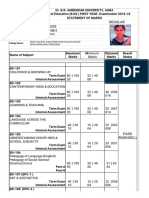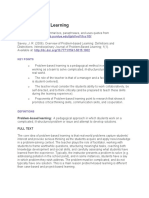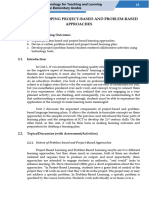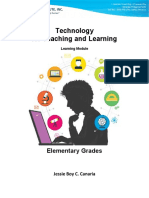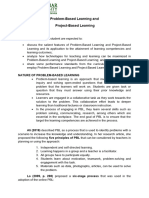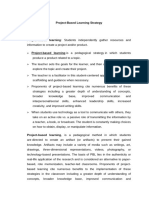0 ratings0% found this document useful (0 votes)
32 viewsProblem Based Learning and Project Based Learning
Problem-Based Learning (PBL) is a teaching method that uses real-world problems to promote student learning of concepts and principles. PBL can develop skills like critical thinking, problem-solving, and communication. It provides opportunities for group work, research, and lifelong learning. Project-Based Learning involves students designing solutions to problems and aims to build creative and collaborative skills.
Uploaded by
gwapak249Copyright
© © All Rights Reserved
Available Formats
Download as PPTX, PDF, TXT or read online on Scribd
0 ratings0% found this document useful (0 votes)
32 viewsProblem Based Learning and Project Based Learning
Problem-Based Learning (PBL) is a teaching method that uses real-world problems to promote student learning of concepts and principles. PBL can develop skills like critical thinking, problem-solving, and communication. It provides opportunities for group work, research, and lifelong learning. Project-Based Learning involves students designing solutions to problems and aims to build creative and collaborative skills.
Uploaded by
gwapak249Copyright
© © All Rights Reserved
Available Formats
Download as PPTX, PDF, TXT or read online on Scribd
You are on page 1/ 19
Problem-Based Learning
and Project-Based Learning
Reported by Group 3
Problem-Based Learning
Problem-Based Learning (PBL) is a teaching method in
which complex real-world problems are used as the
vehicle to promote student learning of concepts and
principles as opposed to direct presentation of facts and
concepts. In addition to course content, PBL can promote
the development of critical thinking skills, problem-
solving abilities, and communication skills. It can also
provide opportunities for working in groups, finding and
evaluating research materials, and life-long learning
(Duch et al, 2001).
Characteristics of a good PBL (Duch, Groh, and Allen, 2001)
The problem must motivate students to seek out a deeper understanding of
concepts.
The problem should require students to make reasoned decisions and to
defend them.
The problem should incorporate the content objectives in such a way as to
connect it to previous courses/knowledge.
If used for a group project, the problem needs a level of complexity to ensure
that the students must work together to solve it.
If used for a multistage project, the initial steps of the problem should be
open-ended and engaging to draw students into the problem.
Why use problem-based learning?
Working in teams.
Managing projects and holding leadership roles.
Oral and written communication.
Self-awareness and evaluation of group processes.
Working independently.
Critical thinking and analysis.
Explaining concepts.
Self-directed learning.
Applying course content to real-world examples.
Researching and information literacy.
Problem solving across disciplines.
Consideration for Using Problem-Based Learning
Rather than teaching relevant material and subsequently having students apply
the knowledge to solve problems, the problem is presented first. PBL assignments
can be short, or they can be more involved and take a whole semester. PBL is often
group-oriented, so it is beneficial to set aside classroom time to prepare students
to work in groups and to allow them to engage in their PBL project.
Students generally must:
Examine and define the problem.
Explore what they already know about underlying issues related to it.
Determine what they need to learn and where they can acquire the information
and tools necessary to solve the problem.
Evaluate possible ways to solve the problem.
Solve the problem.
Report on their findings.
Guidelines in writing PBL problems (Duch et al, 2001)
Choose a central idea, concept, or principle that is always
taught in a given course, and then think of a typical end-of-
chapter problem, assignment, or homework that is usually
assigned to students to help them learn that concept. List the
learning objectives that students should meet when they work
through the problem.
Think of a real-world context for the concept under
consideration. Develop a storytelling aspect to an end-of-
chapter problem, or research an actual case that can be
adapted, adding some motivation for students to solve the
problem.
The problem needs to be introduced in stages so that students
will be able to identify learning issues that will lead them to
research the targeted concepts.
Guidelines in writing PBL problems (Duch et al, 2001)
Establish ground rules at the beginning to prepare students to
work effectively in groups.
Introduce students to group processes and do some warm up
exercises to allow them to practice assessing both their own
work and that of their peers.
Consider having students take on different roles or divide up
the work up amongst themselves. Alternatively, the project
might require students to assume various perspectives, such as
those of government officials, local business owners, etc.
Establish how you will evaluate and assess the assignment.
Consider making the self and peer assessments a part of the
assignment grade.
The following are some questions that
may help guide this process:
What will the first stage look like? What open-ended questions can be asked?
What learning issues will be identified?
How will the problem be structured?
How long will the problem be? How many class periods will it take to
complete?
Will students be given information in subsequent stages as they work through
the problem?
What resources will the students need?
What end product will the students produce at the completion of the
problem?
Here are some questions you might ask:
Why is this a problem?
Why should kids care?
How does the problem affect our community (school, neighborhood,
city/town)?
Is this problem affecting us in our day-to-day lives? How?
What are some ideas for how we might solve this problem?
The method for distributing a PBL problem
falls under three closely related teaching
techniques: case studies, role-plays, and
simulations. Case studies are presented to
students in written form. Role-plays have
students improvise scenes based on character
descriptions given. Today, simulations often
involve computer-based programs. Regardless
of which technique is used, the heart of the
method remains the same: the real-world
problem.
Project-Based Learning
Project-based learning (PBL) involves
students designing, developing, and
constructing hands-on solutions to a problem.
The educational value of PBL is that it aims
to build students’ creative capacity to work
through difficult or ill-structured problems,
commonly in small teams.
Essential Elements of Project-Based Learning
Focuses on a big and open-ended question, challenge, or problem for the
student to research and respond to and/or solve
Brings what students should academically know, understand, and be able to
do into the equation
Is inquiry-based, stimulates intrinsic curiosity, and generates questions as it
helps students seek answers
Uses 21st-century skills such as critical thinking, communication,
collaboration, and creativity, among others.7
Builds student choice into the process
Provides opportunities for feedback and revision of the plan and the project,
just like in real life
Requires students to present their problems, research process, methods, and
results, just as scientific research or real-world projects must stand before
peer review and constructive criticism
Following fifteen years of literature review and distilled
educational experience, the Buck Institute for Education
identified seven essential elements for PBL that focus on
project design. Collectively these elements are called Gold
Standard PBL. According to the BIE, the key elements to
project design include:
A challenging problem or question
Sustained inquiry
Authenticity
Student voice and choice
Reflection
Critique and revision
Public product
Benefits of Project-Based Learning
Project-based learning (PBL) allows students to learn by doing real-world
projects. This is in contrast to traditional learning, which focuses on
memorization and doesn't connect to the real world.
PBL helps students retain information better and be more motivated to learn.
PBL helps students develop important skills like problem-solving, teamwork,
communication, and technology skills. These skills are important for success
in the 21st century.
PBL aligns with modern learning standards that emphasize student agency,
creativity, collaboration, and global citizenship.
Challenges of Project-Based Learning
Project-based learning (PBL) is a different teaching style than what most
teachers are used to. In PBL, teachers coach more and lecture less, they use
interdisciplinary learning, and they are comfortable with uncertainty during
the learning process.
PBL can be challenging for teachers used to traditional methods.
With self-directed PBL, students design projects around their interests but it
can become difficult when students tell you that they don't have any
interests.
PBL gives student choice and freedom, which is wonderful in so many ways
but students may not know what to do with this freedom, especially if they
are new to student-directed PBL.
Students can produce projects that are well below their capabilities.
PBL sometimes use community experts. However, a community expert is not
always accessible and/or students may not want to seek for a community
expert.
Outdoor Project-Based Learning Ideas
Create a new local park, or improve an existing one by adding new features or
providing needed maintenance.
Plant a community garden to provide food for a soup kitchen, food pantry, or
other organization.
Design and create a butterfly, pollinator, or other wildlife garden to support the
local ecosystem.
Build a new walking or biking trail that’s safe for people of all ages to use.
Devise and implement a way to reduce litter in your community.
Set up and manage a school or community compost pile, and distribute the
resulting soil to those who need it most.
Find and help the public use a new way to grow food that requires less soil,
water, or fertilizers, which are in short supply in some parts of the world.
Design, build, and install a completely unique piece of playground equipment
that serves a specific purpose or need.
School Community Project-Based Learning Ideas
Start a comprehensive recycling program at school, or substantially improve
participation in an existing one.
Add collaborative artwork like murals or other displays to school hallways,
bathrooms, or grounds.
Determine a location or program at your school that needs improvement, then
make a plan, raise the funds, and implement your ideas.
Come up with ways to celebrate your school’s diversity and improve
relationships between all students.
Start and run a school store, including inventory, financial plans, and
marketing.
Write a school handbook for new students, with tips and tricks for helping
them feel at home.
Figure out how to offer healthier, better-tasting meals and snacks in the
school cafeteria.
You might also like
- Project Based Learning Powerpoint Presentation100% (5)Project Based Learning Powerpoint Presentation22 pages
- Project-Based Learning Applied to the Language ClassroomFrom EverandProject-Based Learning Applied to the Language ClassroomNo ratings yet
- Revisiting of PB Learning Plan: Integration of The Use of Digital and Non Digital Resources and Assesment Tools in The LP ProcedureNo ratings yetRevisiting of PB Learning Plan: Integration of The Use of Digital and Non Digital Resources and Assesment Tools in The LP Procedure12 pages
- Collaborative Projects Can Be An Effective Way To Approach ProblemNo ratings yetCollaborative Projects Can Be An Effective Way To Approach Problem7 pages
- Reviewer For Final Examination in Teaching Technology in Elementary GradesNo ratings yetReviewer For Final Examination in Teaching Technology in Elementary Grades9 pages
- A project management information systemNo ratings yetA project management information system27 pages
- What Is Project Based Learning and Problem Based LearningNo ratings yetWhat Is Project Based Learning and Problem Based Learning5 pages
- Problem Based Learning and Thinking Based Learning100% (1)Problem Based Learning and Thinking Based Learning20 pages
- Technology For Teaching and Learning: Elementary GradesNo ratings yetTechnology For Teaching and Learning: Elementary Grades9 pages
- By Working With PBL, Students Will:: (I.e., What Is It That You Want Your Students To ReallyNo ratings yetBy Working With PBL, Students Will:: (I.e., What Is It That You Want Your Students To Really5 pages
- Module 5 - Lesson 1 - Writing A Problem-Based or Project-Based Learning Plan100% (1)Module 5 - Lesson 1 - Writing A Problem-Based or Project-Based Learning Plan7 pages
- Project Based Learning (PBL) : Jammu University 2 Year B.Ed. Paper 202/3 Sem: IINo ratings yetProject Based Learning (PBL) : Jammu University 2 Year B.Ed. Paper 202/3 Sem: II19 pages
- L2 Problem Based and Project Based LearningNo ratings yetL2 Problem Based and Project Based Learning22 pages
- People Interacting: 150 Activities to Promote Self Awareness, Communication, Social and Problem-Solving SkillsFrom EverandPeople Interacting: 150 Activities to Promote Self Awareness, Communication, Social and Problem-Solving SkillsNo ratings yet
- The Project Approach in Early Years Provision: A practical guide to promoting children's creativity and critical thinking through project workFrom EverandThe Project Approach in Early Years Provision: A practical guide to promoting children's creativity and critical thinking through project work5/5 (2)
- In Teaching Araling Panlipunan: Constructivism Cognitivism ExperiantialismNo ratings yetIn Teaching Araling Panlipunan: Constructivism Cognitivism Experiantialism2 pages
- 1.perbincangan Kertas Soalan KERTAS 1 (Soalan Objektif)No ratings yet1.perbincangan Kertas Soalan KERTAS 1 (Soalan Objektif)8 pages
- 2023 - Compass Catalog - Low - 230227 PDFNo ratings yet2023 - Compass Catalog - Low - 230227 PDF156 pages
- Unit 2: Lesson 1 Research Useful in Daily Life: What To Know!No ratings yetUnit 2: Lesson 1 Research Useful in Daily Life: What To Know!8 pages
- Episode Ii Learners Development Matrix: PhysicalNo ratings yetEpisode Ii Learners Development Matrix: Physical3 pages
- Project-Based Learning Applied to the Language ClassroomFrom EverandProject-Based Learning Applied to the Language Classroom
- Revisiting of PB Learning Plan: Integration of The Use of Digital and Non Digital Resources and Assesment Tools in The LP ProcedureRevisiting of PB Learning Plan: Integration of The Use of Digital and Non Digital Resources and Assesment Tools in The LP Procedure
- Collaborative Projects Can Be An Effective Way To Approach ProblemCollaborative Projects Can Be An Effective Way To Approach Problem
- Reviewer For Final Examination in Teaching Technology in Elementary GradesReviewer For Final Examination in Teaching Technology in Elementary Grades
- What Is Project Based Learning and Problem Based LearningWhat Is Project Based Learning and Problem Based Learning
- Problem Based Learning and Thinking Based LearningProblem Based Learning and Thinking Based Learning
- Technology For Teaching and Learning: Elementary GradesTechnology For Teaching and Learning: Elementary Grades
- By Working With PBL, Students Will:: (I.e., What Is It That You Want Your Students To ReallyBy Working With PBL, Students Will:: (I.e., What Is It That You Want Your Students To Really
- Module 5 - Lesson 1 - Writing A Problem-Based or Project-Based Learning PlanModule 5 - Lesson 1 - Writing A Problem-Based or Project-Based Learning Plan
- Project Based Learning (PBL) : Jammu University 2 Year B.Ed. Paper 202/3 Sem: IIProject Based Learning (PBL) : Jammu University 2 Year B.Ed. Paper 202/3 Sem: II
- Project Based Learning for Out of School TimeFrom EverandProject Based Learning for Out of School Time
- People Interacting: 150 Activities to Promote Self Awareness, Communication, Social and Problem-Solving SkillsFrom EverandPeople Interacting: 150 Activities to Promote Self Awareness, Communication, Social and Problem-Solving Skills
- The Project Approach in Early Years Provision: A practical guide to promoting children's creativity and critical thinking through project workFrom EverandThe Project Approach in Early Years Provision: A practical guide to promoting children's creativity and critical thinking through project work
- In Teaching Araling Panlipunan: Constructivism Cognitivism ExperiantialismIn Teaching Araling Panlipunan: Constructivism Cognitivism Experiantialism
- 1.perbincangan Kertas Soalan KERTAS 1 (Soalan Objektif)1.perbincangan Kertas Soalan KERTAS 1 (Soalan Objektif)
- Unit 2: Lesson 1 Research Useful in Daily Life: What To Know!Unit 2: Lesson 1 Research Useful in Daily Life: What To Know!




